Canvaswork
Human beings have a natural desire to illuminate, to give forms to shadows.
We know arguments have been made before and will be made again for the
superiority of work that is both utilitarian and beautiful.
Over that which is merely the last, and vice versa ?
Meaning
Canvaswork is a neologism referring to needlework art on canvas. Today,
people refers to canvaswork as needlepoint, but this last is a north
America idiomatic word not used in English language.
Canvaswork has the meaning of the word tapestry, which refers
either to a woven or stitched artwork, in other words to an home artistic or
decorative cloth.
The use of the word tapestry come from latin countries as French,
Italia and Spain.
In east and north european countries weaved or stitched tapestry is called
Gobelin. This word is the name of a
french state manufacture (kingdom to the XVIIth century) which made the most fine
and artistic weaved tapestries of the world, these ones carried out on the
oldest higth loom of the known history. (the same, but biger, loom probably
already used by Penelop).
The terme tapestry is not a misuse. It refers explicitly to a creative work done on the whole surface of a cloth. On an other side, embroidery refers to needlework leaving empty of work the background of the cloth.
Techniques and tools
Canvas
Canvas is the name of a woven material used for needlepoint. It is rectilinear, composed of wrap and woof (horizontal and vertical threads). The lines of these wrap and woof open squares, whose sizes vary with the spacing between the threads. This variation in alignment is called gauge. Canvas during the old past centuries was more akin to a soft linen fabric, than the mesh canvas people use today in needlepoint. Often this canvas was so fine that several hundred stitches could be worked per square inch with silk thread.
Canvas can be bought by the yard and is available in a larges range of
gauges. The higher the thread count to the inch, the finer the canvas. The finer
the canvas, the smaller the stitch.
100% linen canvas can be purchased today and is available in 13 or 17 mesh.
Since such linen canvas cloth or even the imported evenweave linens can
be quite expensive, most people experimenting with canvaswork tend to
purchase one of the following types of cotton canvas:
-
Mono
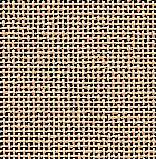 needlepoint canvas single thread canvas available in 10, 12, 13, 14, 16 or 18 mesh, OR
needlepoint canvas single thread canvas available in 10, 12, 13, 14, 16 or 18 mesh, OR
-
Penelope
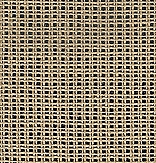 canvas double threaded, available in same mesh sizes as mono canvas, used for
finer detail and durability.
canvas double threaded, available in same mesh sizes as mono canvas, used for
finer detail and durability.
Penelope allows the canvasworker to split the threads for smaller-scale
stitching. Mono is easier and cooperates extremely well with almost all
stitches.
Both Mono and Penelope canvas are measured in terms of mesh sizes (number of
stitched threads per inch), whereas imported linen is measured in terms of
counted threads per inch (hence, 14 count, 18 count, etc.).
Needle
For canvaswork, one uses tapestry needles which have blunted points and long enlarged eyes, which houses the yarn without compression and a blunt point. They come in sizes ranging from 13 to 26 but most likely will be found in sizes 22, 24 and 26. It may be needed the smaller size blunt needles if working with silk or any passing metal threads.
Frame
Frames or stretcher bars, manufactured in graded sizes, are not a requirement for doing canvaswork, but they make for easier blocking and they help prevent distortion of the needlework.
Working with frames imply that one hand ply the needle from above the canvas while the other remains underneath for reciprocal move. That methode makes more regular aspect of the stitch and as the thread go through the canvas verticaly right it do not wears out at all keeping then the smoothness of the thread.
Stitches
Stitches have been lovingly manufactured by the hand for countless centuries. Archaeological finds may still brings many surprises. Referred to as needlework rather than embroidery, canvaswork employed a repertoire of various stitches. In the late XVIth c. the basic stitch of canvaswork was the Gros point; mainly as cross stitch but often too the Demi point as Tent sitch.
Tent stitch (demi-Point de croix i.e. half of a cross-stitch,) which first appeared in the 13th c. in combination with other stitches were worked in a variety of directions on the same piece, they proved quite effective for the sake of appearance.
Later, for the need of uphoslteries was devised the Petit Point (basketweave). Inherently strong, it is since the best stitch on home furnishing for working designs on seat cushions, kneeling pillows, chair and armchair covering etc.
The Tufted stitch canvaswork was early used to imitate the Middle Eastern
method of making carpets. This weaving technique was first introduced in
occidental countries by the
Savonnerie
French Royal manufacture.
Shifted in canvaswork, the stitch is characterized by the formation of long
loops that are either retained or scissored into a tufted surface. Instead of
using the fingers to twist knots, the needleworker make a series of loops,
securing each one going along, with a form of back stitch, and then clipping the
whole thing afterward to form a pile.
Since the evenweave linen ground for canvaswork is completely covered, other
stitches which migth be used include upright Gobelin, Aubusson,
long-armed cross stitch and plait or plaited braid.
Running, stem, satin and sometimes even chain stitch are good detail stitches
for canvaswork. See
diagrams for the gobelin
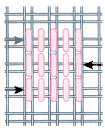 , brick (particularelly beautiful and useful for grounds),
long-armed cross stitch and plaited stitch. The
Florentine
, brick (particularelly beautiful and useful for grounds),
long-armed cross stitch and plaited stitch. The
Florentine
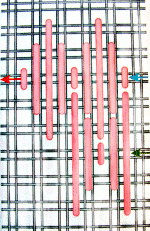 or
Bargello stitch
or
Bargello stitch
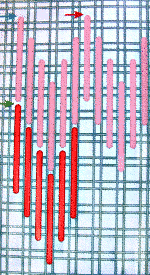 . was also a popular canvaswork style
since Renaissance era until early XVIIth century.
. was also a popular canvaswork style
since Renaissance era until early XVIIth century.
Throughhout history Canvaswork has been responsible for much if not most of the geometric textilework. Tribal peoples in Turkestan, the Caucausus, Turkey and Persia are the creators of the truly extraordinary carpets, saddle bags, tent furnishing and camel rugs of the middle East. The counted, geometric stitches has been used too in the Occident since XIIIth century. As Erica Wilson notes in her Embroidery Book, an altar frontal done in Germany (formerly East Germany) was embroidered on coarse linen using silk threads and counted, geometric stitches.
It was also not uncommon to find human figures needleworked on canvas and then cut out and applied to such luxurious fabrics as velvet. This cut-and-apply method created a rich effect with the silk and metal thread against the velvet. Secondly, it was much easier and quicker to needlework linen then directly on velvet. The cushion known as "Fancie of a Fowler" serves as a fine example of this process, as well as a study of late XVIth c. Elizabethan costuming. The professionally worked figures were done in silk and metal thread featuring Bess of Hardwick and members of her family, mostly in tent stitch and upright gobelin stitches. The figures, once worked, were then cut out and applied to purple velvet. It was also not unusual to find such cut-and-applied canvaswork combined on the same ground fabric with appliqued fabric work and other surface embroidery techniques.
Inspiration
Since origin through renaissance and until XIXth era needleworkers were copying European pictorial tapestry designs onto canvas. Aras, Tournai, Loire valey and flemish woven tapestries, especially those depicting human figures and those skillfully woven with silk and metal threads, were admired, coveted, but over all expensive.
Further inspired by the colorful carpets coming out from Sarazin lands (the Middle East countries) and the printing of herbals and bestiaries, occidental counties quickly adopted these ideas to agreement their home comfort. Not only was canvaswork is used to train young girls in needlework (See Madam de Maintenon), but also to decorate great manors. Inside these manors, canvaswork decorated bed hangings, wall hangings, bed canopies, head cloths, curtains, bed testers, kneeling pillows, seat covering, seat cushions, table carpets and cupboard cloths. Keep in mind that there were in middle age and renaissance period more hard benches than upholstered chairs, and the bedroom was in and of itself a state chamber in a noble's home. So warmth, grandeur and comfort were major household concerns of the wealthy that inspired the production of such canvaswork.
No different than earlier professional embroideries, craftsman skilled in painting and design often created the designs for the canvas and then left it to the professional embroiderers to do the needlework. Although canvaswork was not out of the framework of being worked by amateurs, the mere size of some pieces and the detailed design and fineness of stitches indicate that professional craftsman and embroiderers were employed.
Colors and material
Colors before XIXth century where only made from vegetable or mineral. It is why
the range in use at those time did not cover all shades found in real world as
the one we have now from chimical pigments.
The wool stitches were worked in colors of blues, creams, greens, using
three shades and reds, brown, light sepia, lilac using two shades, and at last
the black.
By using silk thread, the linen canvas could be worked in brilliant colors
too, in a variety of shades, and was stitched with very small "quart de
point", as referred by French stitcher. The silk threads used were light
blue, green, white and yellow. Colors such as pale orange and shades of pink,
blue-green and yellow were not uncommon in canvaswork.
The use of gold and siver threads helped not for less to add ligth. Metal
thread was used extensivelly for dress and symbols of wealthy or nobility.
Worsted wool thread (known as crewel in the Middle Ages) was used for canvaswork in the XVIth century. Today, needleworkers can purchase:
- Paternayan's Persian wool 3 stranded, easily divided, usually use 2 strands for canvaswork, easiest to work in 30 inch lengths;
- DMC Medici and Broider Wul are both single-stranded 100% virgin wool in muted shades. The Broider Wul is hand-dyed. You can't use lengths much longer than 18 inches, frays easily, usually use 2 strands for canvaswork; and
- DMC or Anchor Tapestry wool single thread, larger in diameter, doesn't tangle, nice colors.
Silk threads that today's needleworkers can purchase include:
- Soie d'Alger ® 7 stranded, divisible, and available in almost 600 colors;
- Soie Gobelins® 2 ply twisted filament silk, and
- Trebizond Twisted Silk sold in 10 meter spools, perfect for tent stitch on 18-mesh canvas.
| LOUIS XIII | LOUIS XIV | REGENCE | LOUIS XV | LOUIS XVI | DIRECTOIRE | EMPIRE | RESTAURATION | NAPOLEON III | ART-DECO |
| You may E-mail us to: |
|
Tel & Fax:+33 142 606 567 |
| Tapisserie de France © All rights reserved |